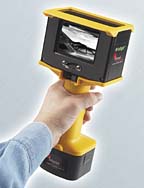Product Profile: Infrared Imaging

Ask Kurt Scepaniak of Horizon Roofing Inc., Waite Park, Minn. Horizon Roofing specializes in installing commercial flat roofs, roof maintenance, copper work and high-end residential roofing. Kurt says that about two years ago, Horizon Roofing invested in two infrared cameras from Infrared Solutions Inc., Plymouth, Minn.
"Using infrared photography has helped us earn a reputation as a roofing company that can find leaks no one else can," says Scepaniak. "It's also helped our bottom line, as we can complete a roof inspection in one-half to one-quarter of the time a traditional visual inspection can take."
He continues: "We have gotten calls from desperate building owners. They say they have had five or six contractors come out to try to find and plug the leak, but they still have water damage. One apartment complex manager called us to say that if something wasn't done soon, they'd be out of tenants." Apparently, this complex was the victim of a combination of a poor job site, sloppy workmanship and bad design. Twelve out of 16 buildings had leaks so bad, tenants were moving out. Since Horizon Roofing determined the source of the leak and repaired the damage, not one tenant has left the complex.
In another example, after a Minnesota school found it had a roof leak, it called several contractors who could not find the problem. Months went by, and the school became increasingly concerned about the potential of developing sick building syndrome. Mold, wood rot, rusting metal and higher heat bills became priority issues too, as they continued to find wet insulation throughout the building. Horizon Roofing was able to locate a series of small cracks in the roof and the walls that created a maze of water runnels throughout the school. After the leaks were stopped, Horizon helped the school find all the wet insulation, wet drywall and remaining enclosed puddles. The standing water and humidity problems were dried out and the building has been trouble-free since. After the repairs were completed, Horizon Roofing came back to confirm that all is well, and all is dry.
Scepaniak believes that the infrared cameras give Horizon Roofing a competitive edge. "We have two Infrared Solutions IR cameras. One is the Insight® model and the other is the FlexCam® T model. The Insight is the camera we use for most of our roof inspections. We use the more advanced FlexCam T in our other business (electrical and mechanical inspecting). Insurance companies typically require yearly electrical panel inspections in most manufacturers. We use the FlexCam T to identify what circuits are running hotter than they should be, so they can be switched out during downtime, rather than having a line or the whole plant go dark. This also greatly reduces the risk of electrical fires and short circuits," says Scepaniak.
IR photography gives Horizon Roofing the ability to find these leaks because:
It tracks moisture. Moisture will be a different temperature than walls or insulation, so IR thermographic photography can be used to trace moisture pathways and points of entrance.
If standing water has already been removed from the building and the leak has supposedly been plugged, IR can help confirm the absence of standing water and confirm there is no more water flowing into the building.
Horizon Roofing's competitive advantage was earned. Scepaniak says that IR cameras can be pricey and that learning to use them properly takes discipline and dedication. You can expect to pay from $10,000-$60,000 for the camera and software (Infrared Solutions offers a wide range of cameras and options from $10,000 to under $25,000). Scepaniak believes that purchasing the IR cameras was an investment that will have an excellent return with increased revenue and improved profitability.
One additional caveat is that, to do electrical inspections for insurance purposes, you need to go to school to become a certified thermographer. Again, it's an investment with a good payoff. Using IR photography for roofing inspections does not require certification or schooling.
One reason Horizon Roofing selected Infrared Solutions' cameras is because they are easy to use. The FlexCam T has software that is very intuitive, says Scepaniak. "Its ‘enter' button and other buttons function almost identically to a computer mouse. The dropdown menus are clear and easy to navigate. With a press of a button, right on the camera's display, I can see thumbnails of all the shots I have taken. In fact, this camera is so easy to use, the instructor at the thermography school I attended used my FlexCam T for demonstration purposes. The cameras have settings that are both easy to find and use," says Scepaniak.
Looking for a reprint of this article?
From high-res PDFs to custom plaques, order your copy today!



.webp?height=200&t=1651694007&width=200)
